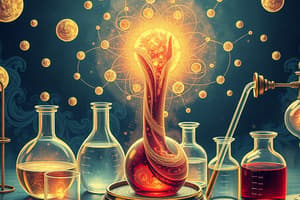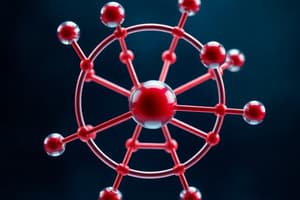Podcast
Questions and Answers
What are periodic properties?
What are periodic properties?
Properties whose values can be predicted based on the element's position on the periodic table.
What is the basis for the transmission of nerve signals?
What is the basis for the transmission of nerve signals?
Movement of ions across cell membranes.
In what directions are Na+ and K+ ions pumped across membranes through ion channels?
In what directions are Na+ and K+ ions pumped across membranes through ion channels?
Na+ moves out, K+ moves in.
How do we represent orbitals?
How do we represent orbitals?
What is electron configuration?
What is electron configuration?
What is the Pauli exclusion principle?
What is the Pauli exclusion principle?
What does each electron in a multielectron atom experience?
What does each electron in a multielectron atom experience?
What is the effective nuclear charge?
What is the effective nuclear charge?
What happens when the electrons are closer to the nucleus?
What happens when the electrons are closer to the nucleus?
The better an outer electron is at penetrating through the electron cloud of inner electrons...
The better an outer electron is at penetrating through the electron cloud of inner electrons...
What is the Aufbau principle?
What is the Aufbau principle?
What is Hund's rule?
What is Hund's rule?
What are the general rules for writing electron configurations?
What are the general rules for writing electron configurations?
How can electron configurations of all elements except hydrogen and helium be represented?
How can electron configurations of all elements except hydrogen and helium be represented?
What are the valence electrons?
What are the valence electrons?
What are core electrons?
What are core electrons?
What are the main group elements (representative elements)?
What are the main group elements (representative elements)?
What group are the noble gases?
What group are the noble gases?
What group are the transition metals?
What group are the transition metals?
What make up the f-block transition elements?
What make up the f-block transition elements?
What is the effective nuclear charge (Z-eff)?
What is the effective nuclear charge (Z-eff)?
How does the value of the effective nuclear charge increase?
How does the value of the effective nuclear charge increase?
What is the atomic radius?
What is the atomic radius?
How does the atomic radius increase?
How does the atomic radius increase?
How does the atomic radius decrease?
How does the atomic radius decrease?
What is the ionization energy (IE)?
What is the ionization energy (IE)?
What happens to the ionization energy as the Z-eff increases?
What happens to the ionization energy as the Z-eff increases?
Why is removing a paired electron easier?
Why is removing a paired electron easier?
Why does it take more energy to remove the second, third, fourth, and so on electrons?
Why does it take more energy to remove the second, third, fourth, and so on electrons?
What is electron affinity (EA)?
What is electron affinity (EA)?
How does electron affinity increase?
How does electron affinity increase?
Is it easier to add an electron to an s orbital than to add one to a p orbital with the same quantum number?
Is it easier to add an electron to an s orbital than to add one to a p orbital with the same quantum number?
Characteristics of metals include:
Characteristics of metals include:
Characteristics of nonmetals include:
Characteristics of nonmetals include:
Characteristics of metalloids are:
Characteristics of metalloids are:
What is the definition of isoelectronic?
What is the definition of isoelectronic?
What is the ionic radius?
What is the ionic radius?
What happens to the radius when an atom loses an electron to become a cation?
What happens to the radius when an atom loses an electron to become a cation?
What happens to the radius when an atom gains one or more electrons to become an anion?
What happens to the radius when an atom gains one or more electrons to become an anion?
What is an isoelectronic series?
What is an isoelectronic series?
How many valence electrons do the alkaline earth metals possess?
How many valence electrons do the alkaline earth metals possess?
A cation of +2 indicates that an element has?
A cation of +2 indicates that an element has?
For a particular element, identify the species that has the smallest radius.
For a particular element, identify the species that has the smallest radius.
Identify the elements correctly showing decreasing radii size.
Identify the elements correctly showing decreasing radii size.
Place the following in order of increasing first ionization energy: N, F, As.
Place the following in order of increasing first ionization energy: N, F, As.
Give the electron configuration for O.
Give the electron configuration for O.
Of the following, which atom has the largest atomic radius?
Of the following, which atom has the largest atomic radius?
Place the following in order of decreasing magnitude of lattice energy: K2O, Rb2S, Li2O.
Place the following in order of decreasing magnitude of lattice energy: K2O, Rb2S, Li2O.
Identify the weakest bond.
Identify the weakest bond.
Give the number of valence electrons for XeI2.
Give the number of valence electrons for XeI2.
A reaction is exothermic when:
A reaction is exothermic when:
Identify an ionic bond.
Identify an ionic bond.
Identify a bond with covalent bonding.
Identify a bond with covalent bonding.
What is the Lewis theory?
What is the Lewis theory?
What do Lewis structures allow us to predict?
What do Lewis structures allow us to predict?
Why do chemical bonds form?
Why do chemical bonds form?
What types of atoms make up an ionic bond?
What types of atoms make up an ionic bond?
What type of atoms make up a covalent bond?
What type of atoms make up a covalent bond?
What type of atoms make up a metallic bond?
What type of atoms make up a metallic bond?
What happens when a metal atom loses electrons?
What happens when a metal atom loses electrons?
What happens when a nonmetal gains electrons?
What happens when a nonmetal gains electrons?
How many valence electrons do transition metals have?
How many valence electrons do transition metals have?
Metals form _____ by losing valence shell electrons.
Metals form _____ by losing valence shell electrons.
Nonmetals form ______ by gaining valence electrons.
Nonmetals form ______ by gaining valence electrons.
For main group metals, the number of dots indicates:
For main group metals, the number of dots indicates:
For nonmetals in the second period, the number of unpaired dots indicates:
For nonmetals in the second period, the number of unpaired dots indicates:
What is lattice energy?
What is lattice energy?
What is electronegativity?
What is electronegativity?
If the difference in electronegativity between bonded atoms is 0, what type of bond is it?
If the difference in electronegativity between bonded atoms is 0, what type of bond is it?
If the difference in electronegativity between bonded atoms is between 0.1-0.4, what type of bond is it?
If the difference in electronegativity between bonded atoms is between 0.1-0.4, what type of bond is it?
If the difference in electronegativity between bonded atoms is 0.5-1.9, what type of bond is it?
If the difference in electronegativity between bonded atoms is 0.5-1.9, what type of bond is it?
If the difference in electronegativity between bonded atoms is 2.0 or greater, what type of bond is it?
If the difference in electronegativity between bonded atoms is 2.0 or greater, what type of bond is it?
What is dipole moment?
What is dipole moment?
What is formal charge?
What is formal charge?
What is the sum of all formal charges in a molecule?
What is the sum of all formal charges in a molecule?
What is bond energy?
What is bond energy?
Flashcards are hidden until you start studying
Study Notes
Periodic Properties and Electron Configuration
- Periodic properties are predictable based on an element's position in the periodic table.
- Electron configuration describes the distribution of electrons in atomic orbitals.
- The Pauli exclusion principle states that no two electrons can have identical quantum numbers.
- Effective nuclear charge is the attraction experienced by electrons from the nucleus, increasing from left to right.
Ion Movement and Nerve Signals
- Nerve signals are transmitted through the movement of ions across cell membranes, with Na+ ions moving out and K+ ions moving in.
Orbital Representation and Electron Rules
- Orbitals are represented as squares, with electrons depicted as arrows; arrow direction indicates electron spin.
- The Aufbau principle dictates filling the lowest energy orbitals first.
- Hund's rule states that electrons fill degenerate orbitals singly before pairing.
Atomic and Ionic Sizes
- Atomic radius is the distance from the nucleus to the valence shell, increasing down a group and decreasing across a period.
- Cations are smaller than their parent atoms due to reduced electron-electron repulsions after losing electrons.
- Anions are larger due to increased electron-electron repulsions after gaining electrons.
Ionization Energy and Electron Affinity
- Ionization energy (IE) is the energy needed to remove an electron from an atom in the gas phase, increasing with effective nuclear charge.
- Electron affinity (EA) is the energy change when an atom accepts an electron, also increasing across a period.
Bonds and Lattice Energy
- Cations are formed by the loss of electrons, while anions are formed by the gain of electrons.
- Ionic bonds involve the transfer of electrons between metals and nonmetals, whereas covalent bonds involve sharing electrons between nonmetals.
- Lattice energy measures the energy required to separate ions in an ionic solid, always exothermic.
Electronegativity and Bond Types
- Electronegativity is the ability of an atom to attract bonding electrons, increasing across a period and decreasing down a group.
- Bond types vary based on the difference in electronegativity:
- 0 = pure covalent
- 0.1-0.4 = nonpolar covalent
- 0.5-1.9 = polar covalent
- ≥2.0 = ionic
Lewis Structures and Formal Charge
- Lewis structures depict molecular stability and bonding characteristics, focusing on valence electrons.
- Formal charge is a hypothetical charge used to assess potential resonance structures, with the sum in a neutral molecule being zero.
Key Atomic Concepts
- Valence electrons are the outermost electrons that determine chemical reactivity.
- Core electrons reside in inner shells and do not participate in bonding.
- Transition metals typically have two valence electrons, unlike main group elements which vary.
Chemical Reactions
- Exothermic reactions occur when weak bonds break and strong bonds form, releasing energy in the process.
- Bond energy refers to the energy needed to break one mole of a bond, always positive.
This summary captures essential concepts and principles necessary for understanding chemical properties and behavior based on the provided flashcards.
Studying That Suits You
Use AI to generate personalized quizzes and flashcards to suit your learning preferences.




